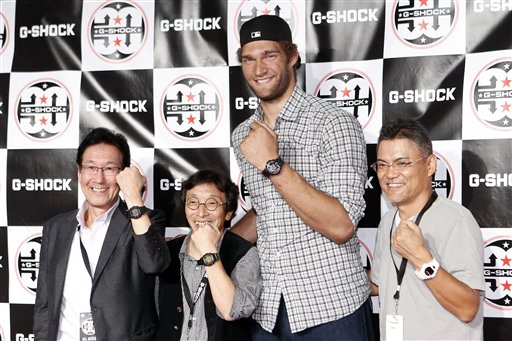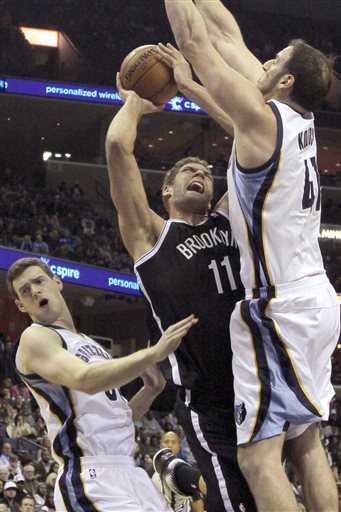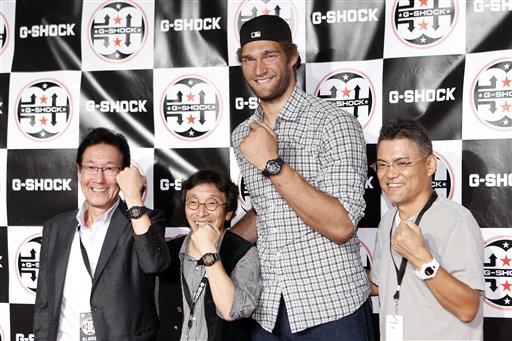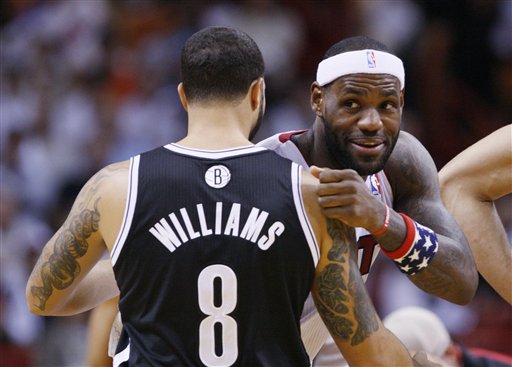
In the fourth quarter, the Brooklyn Nets laid waste to what was a fifteen-point lead at one point, letting the Grizzlies claw back to within two points and make a game out of what was teetering on the edge of a blowout. With their backs against the wall, the Nets played a simplified offense run through Brook Lopez to perfection, and it ended in a 97-88 Nets victory.
Lopez struggled early in the first quarter in the post, hitting one of his first six shots in post-up situations and struggling mightily with Memphis Grizzlies center Kosta Koufos’s length and strength. The one shot he did make in the post was a turnaround jumper from 15 feet in the first quarter, rather than pounding his back into the basket.
With Lopez fatigued, Kidd pulled him and Kevin Garnett gave him a pick-me-up as Joe Johnson ran the offense, floating between Iso-Joe and offensive Flow-Joe (Flo-Joe will probably not take off as a nickname.) In the middle quarters, the Nets used Andray Blatche for long stretches, who both did good, sane things (offensive rebounding, manning the paint) and good insane things (hitting a career-high three three-pointers, creating off the dribble from the three-point line for a layup. Indeed, Blatche scored 17 of his 21 points in the middle quarters, playing more time in the second and third than Lopez.
Then, when the Nets needed to maintain a lead in the fourth quarter, they went straight to Lopez, who played one of his best stretches of post play in his career.

The plays were directive, not diagrammed: get Lopez the ball on the left block, spread the floor with one shooter on the strong side and the rest on the weak side, and let him cook.
Lopez has struggled with turnovers out of the post in his career, particularly from those double-teams, but he’s gotten better and better with each season. He’s come incredibly far from this enormous, plodding ball of potential in 2010, who always had the soft scoring touch but couldn’t quite read when guards were sneaking in on him:
Fast-forward four years, and here’s a compilation of the three three-point looks created out of Lopez (who, holy crap, looks stronger) in the post. Watch as he times these as close to perfectly as possible, draws in defenders, then kicks a pass out to his one-pass-away teammate as the defense commits — before the defender can cause Lopez real problems.
There’s a common thread on each of these possessions. Lopez sets up on the block and begins backing down, but with an eye on the strong-side defender above him. When the defender commits to Lopez, he fires a bounce pass away from the post to the open man, leading to either an open three-pointer for Joe Johnson or a switch that leads to another open three-pointer for Mirza Teletovic.
Though the Nets only made one of the three threes, it’s the open look that’s created that matters here, in what has the potential to be a finely tuned, explosive offensive ecosystem: Lopez reading the double-team, Kidd spreading the floor with shooters, and the Nets making snap decisions to take advantage of good looks at the basket.
Lopez turned the ball over on 13.5% of his possessions in the post in 2009-10, many of them when a second defender snuck into his space without his knowledge. As the chart below shows, he’s gotten a little better at limiting turnovers each year, and this year he’s cut that number down to just 7.4.
Don’t see the chart above? Refresh the page. Still don’t see it? Here’s the non-interactive image.
It’s early, but the trendline is clear: the less Lopez gives up possession, the more possessions he scores on. So far, Lopez has only turned the ball over on 7.4% of his post-up possessions, and it’s because of quicker decisions like the ones he made in the fourth quarter against the Grizzlies.
When the Grizzlies didn’t bring the double-team, Lopez just bore down and made them pay, possession after possession, reducing Ed Davis and Koufos to cubs. He finished the fourth quarter with 12 points on 4-6 shooting, drawing four shooting fouls:
Lopez is the whole package in the post. His footwork, strength, and fluidity have all grown dramatically since his rookie season; while he may only have five or six dependable moves, they’re all lethal. He’s now scoring on over 63% of his shoot/foul/turnover touches in the post this season, and his 1.16 points per possession ranks second in the league. But what makes him so impossible to guard is his shooting touch: Lopez can palm the basketball with either one of his monster hands and use his 7’7″ wingspan to toss it over nearly any defender.
Going through Lopez through all four quarters isn’t a viable strategy. He can only have so many possessions run through him before he tires out, which is why Joe Johnson and Andray Blatche were so crucial while Lopez rested. He also tends to force the issue sometimes, as he did in the first quarter. However, the Nets did an excellent job of regulating when he saw the ball, and Lopez responded by ensuring that he wasn’t the only threat on the floor when he set up on the block. If he plays like he did down the stretch Saturday night, he might be an unstoppable force in the post — even when he’s not the one shooting.

















